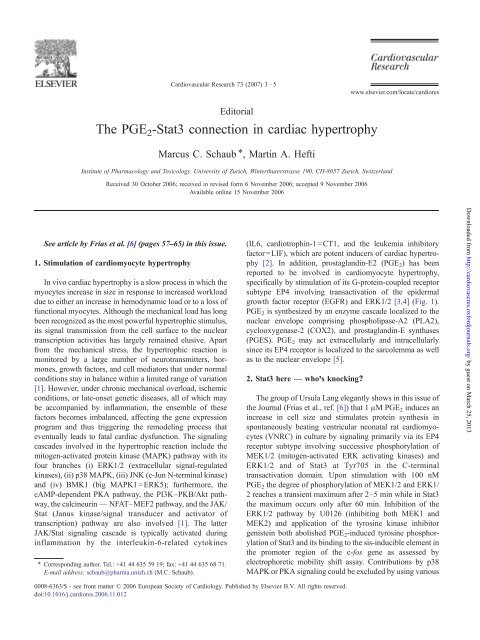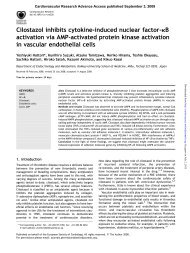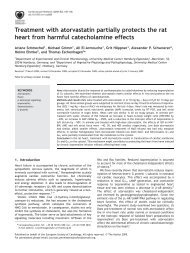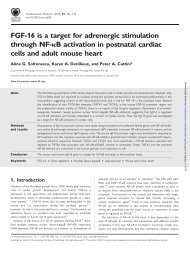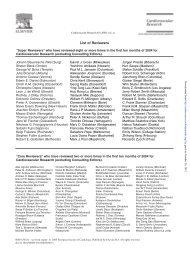The PGE2-Stat3 connection in cardiac hypertrophy - Cardiovascular ...
The PGE2-Stat3 connection in cardiac hypertrophy - Cardiovascular ...
The PGE2-Stat3 connection in cardiac hypertrophy - Cardiovascular ...
Create successful ePaper yourself
Turn your PDF publications into a flip-book with our unique Google optimized e-Paper software.
Editorial<br />
<strong>The</strong> PGE 2-<strong>Stat3</strong> <strong>connection</strong> <strong>in</strong> <strong>cardiac</strong> <strong>hypertrophy</strong><br />
Marcus C. Schaub ⁎ , Mart<strong>in</strong> A. Hefti<br />
Institute of Pharmacology and Toxicology, University of Zurich, W<strong>in</strong>terthurerstrasse 190, CH-8057 Zurich, Switzerland<br />
Received 30 October 2006; received <strong>in</strong> revised form 6 November 2006; accepted 9 November 2006<br />
Available onl<strong>in</strong>e 15 November 2006<br />
See article by Frias et al. [6] (pages 57–65) <strong>in</strong> this issue.<br />
1. Stimulation of cardiomyocyte <strong>hypertrophy</strong><br />
<strong>Cardiovascular</strong> Research 73 (2007) 3 – 5<br />
In vivo <strong>cardiac</strong> <strong>hypertrophy</strong> is a slow process <strong>in</strong> which the<br />
myocytes <strong>in</strong>crease <strong>in</strong> size <strong>in</strong> response to <strong>in</strong>creased workload<br />
due to either an <strong>in</strong>crease <strong>in</strong> hemodynamic load or to a loss of<br />
functional myocytes. Although the mechanical load has long<br />
been recognized as the most powerful hypertrophic stimulus,<br />
its signal transmission from the cell surface to the nuclear<br />
transcription activities has largely rema<strong>in</strong>ed elusive. Apart<br />
from the mechanical stress, the hypertrophic reaction is<br />
monitored by a large number of neurotransmitters, hormones,<br />
growth factors, and cell mediators that under normal<br />
conditions stay <strong>in</strong> balance with<strong>in</strong> a limited range of variation<br />
[1]. However, under chronic mechanical overload, ischemic<br />
conditions, or late-onset genetic diseases, all of which may<br />
be accompanied by <strong>in</strong>flammation, the ensemble of these<br />
factors becomes imbalanced, affect<strong>in</strong>g the gene expression<br />
program and thus trigger<strong>in</strong>g the remodel<strong>in</strong>g process that<br />
eventually leads to fatal <strong>cardiac</strong> dysfunction. <strong>The</strong> signal<strong>in</strong>g<br />
cascades <strong>in</strong>volved <strong>in</strong> the hypertrophic reaction <strong>in</strong>clude the<br />
mitogen-activated prote<strong>in</strong> k<strong>in</strong>ase (MAPK) pathway with its<br />
four branches (i) ERK1/2 (extracellular signal-regulated<br />
k<strong>in</strong>ases), (ii) p38 MAPK, (iii) JNK (c-Jun N-term<strong>in</strong>al k<strong>in</strong>ase)<br />
and (iv) BMK1 (big MAPK1 =ERK5); furthermore, the<br />
cAMP-dependent PKA pathway, the PI3K–PKB/Akt pathway,<br />
the calc<strong>in</strong>eur<strong>in</strong> — NFAT–MEF2 pathway, and the JAK/<br />
Stat (Janus k<strong>in</strong>ase/signal transducer and activator of<br />
transcription) pathway are also <strong>in</strong>volved [1]. <strong>The</strong> latter<br />
JAK/Stat signal<strong>in</strong>g cascade is typically activated dur<strong>in</strong>g<br />
<strong>in</strong>flammation by the <strong>in</strong>terleuk<strong>in</strong>-6-related cytok<strong>in</strong>es<br />
⁎ Correspond<strong>in</strong>g author. Tel.: +41 44 635 59 19; fax: +41 44 635 68 71.<br />
E-mail address: schaub@pharma.unizh.ch (M.C. Schaub).<br />
(IL6, cardiotroph<strong>in</strong>-1 =CT1, and the leukemia <strong>in</strong>hibitory<br />
factor=LIF), which are potent <strong>in</strong>ducers of <strong>cardiac</strong> <strong>hypertrophy</strong><br />
[2]. In addition, prostagland<strong>in</strong>-E2 (<strong>PGE2</strong>) has been<br />
reported to be <strong>in</strong>volved <strong>in</strong> cardiomyocyte <strong>hypertrophy</strong>,<br />
specifically by stimulation of its G-prote<strong>in</strong>-coupled receptor<br />
subtype EP4 <strong>in</strong>volv<strong>in</strong>g transactivation of the epidermal<br />
growth factor receptor (EGFR) and ERK1/2 [3,4] (Fig. 1).<br />
<strong>PGE2</strong> is synthesized by an enzyme cascade localized to the<br />
nuclear envelope compris<strong>in</strong>g phospholipase-A2 (PLA2),<br />
cyclooxygenase-2 (COX2), and prostagland<strong>in</strong>-E synthases<br />
(PGES). <strong>PGE2</strong> may act extracellularly and <strong>in</strong>tracellularly<br />
s<strong>in</strong>ce its EP4 receptor is localized to the sarcolemma as well<br />
as to the nuclear envelope [5].<br />
2. <strong>Stat3</strong> here — who's knock<strong>in</strong>g?<br />
www.elsevier.com/locate/cardiores<br />
<strong>The</strong> group of Ursula Lang elegantly shows <strong>in</strong> this issue of<br />
the Journal (Frias et al., ref. [6]) that 1 μM PGE 2 <strong>in</strong>duces an<br />
<strong>in</strong>crease <strong>in</strong> cell size and stimulates prote<strong>in</strong> synthesis <strong>in</strong><br />
spontaneously beat<strong>in</strong>g ventricular neonatal rat cardiomyocytes<br />
(VNRC) <strong>in</strong> culture by signal<strong>in</strong>g primarily via its EP4<br />
receptor subtype <strong>in</strong>volv<strong>in</strong>g successive phosphorylation of<br />
MEK1/2 (mitogen-activated ERK activat<strong>in</strong>g k<strong>in</strong>ases) and<br />
ERK1/2 and of <strong>Stat3</strong> at Tyr705 <strong>in</strong> the C-term<strong>in</strong>al<br />
transactivation doma<strong>in</strong>. Upon stimulation with 100 nM<br />
PGE 2 the degree of phosphorylation of MEK1/2 and ERK1/<br />
2 reaches a transient maximum after 2–5 m<strong>in</strong> while <strong>in</strong> <strong>Stat3</strong><br />
the maximum occurs only after 60 m<strong>in</strong>. Inhibition of the<br />
ERK1/2 pathway by U0126 (<strong>in</strong>hibit<strong>in</strong>g both MEK1 and<br />
MEK2) and application of the tyros<strong>in</strong>e k<strong>in</strong>ase <strong>in</strong>hibitor<br />
geniste<strong>in</strong> both abolished <strong>PGE2</strong>-<strong>in</strong>duced tyros<strong>in</strong>e phosphorylation<br />
of <strong>Stat3</strong> and its b<strong>in</strong>d<strong>in</strong>g to the sis-<strong>in</strong>ducible element <strong>in</strong><br />
the promoter region of the c-fos gene as assessed by<br />
electrophoretic mobility shift assay. Contributions by p38<br />
MAPK or PKA signal<strong>in</strong>g could be excluded by us<strong>in</strong>g various<br />
0008-6363/$ - see front matter © 2006 European Society of Cardiology. Published by Elsevier B.V. All rights reserved.<br />
doi:10.1016/j.cardiores.2006.11.012<br />
Downloaded from<br />
http://cardiovascres.oxfordjournals.org/ by guest on March 25, 2013
4 M.C. Schaub, M.A. Hefti / <strong>Cardiovascular</strong> Research 73 (2007) 3–5<br />
Fig. 1. Simplified scheme of the major routes connected with PGE 2<br />
signal<strong>in</strong>g. PGE 2 is synthesized by enzymes on the nuclear envelope surface.<br />
<strong>The</strong> <strong>PGE2</strong> receptor subtype EP4 locates to the cell membrane and to the<br />
nuclear envelope. <strong>The</strong> EP4 receptor is able to couple with either Gs or Gi<br />
prote<strong>in</strong>s; when coupl<strong>in</strong>g to Gi, the heterodimeric Gβ/γ component is<br />
thought to activate the PI3K-PKB path [13]. <strong>The</strong> PI3K-dependent activation<br />
of the MEK-ERK pathway is not yet def<strong>in</strong>ed <strong>in</strong> detail. Angtg is<br />
<strong>in</strong>tracellularly transformed to AngII before secretion. <strong>The</strong> AngII receptor<br />
AT1 may signal via Gq as well as by direct <strong>in</strong>teraction with several adapter<br />
prote<strong>in</strong>s <strong>in</strong>clud<strong>in</strong>g β-arrest<strong>in</strong>, Src, and JAK. Both EP4 and AT1 receptors<br />
can transactivate the EGF receptor (a receptor tyros<strong>in</strong>e k<strong>in</strong>ase=RTK).<br />
ERK1/2 occurs <strong>in</strong> the cytosolic and nuclear fractions. <strong>The</strong> IL6-related<br />
cytok<strong>in</strong>es may be secreted and act <strong>in</strong> a paracr<strong>in</strong>e and autocr<strong>in</strong>e manner while<br />
<strong>PGE2</strong> may also act <strong>in</strong> an <strong>in</strong>tracr<strong>in</strong>e manner on the nuclear EP4 receptors. For<br />
full transcriptional activation <strong>Stat3</strong> requires phosphorylation at Tyr705 by<br />
JAK and at Ser727 by ERK. Abbreviations are <strong>in</strong> the text except for: DAG,<br />
diacylglycerol; GSK, glycogen synthase k<strong>in</strong>ase; iNOS, <strong>in</strong>ducible NO<br />
synthase; PI3K, phospho<strong>in</strong>ositide 3-k<strong>in</strong>ase.<br />
<strong>in</strong>hibitors and activators of these pathways. Furthermore,<br />
transfection of VNRC with small <strong>in</strong>terfer<strong>in</strong>g RNA (siRNA)<br />
specifically target<strong>in</strong>g the rat <strong>Stat3</strong> reduced expression of the<br />
latter by ∼70% and <strong>in</strong>hibited the hypertrophic reaction. <strong>The</strong><br />
requirement of 1 μM <strong>PGE2</strong> for elicit<strong>in</strong>g the hypertrophic<br />
reaction observed <strong>in</strong> VNRC seems rather high <strong>in</strong> view of the<br />
∼10,000-fold lower physiological plasma levels (60–<br />
110 pM) <strong>in</strong> the rat [7]. <strong>The</strong> authors may argue, however,<br />
that the <strong>in</strong>tracellular biosynthesis of PGE 2 could lead to<br />
significantly higher local concentrations than that found<br />
extracellularly <strong>in</strong> the plasma. Blockade of the delayed<br />
Tyr705 phosphorylation of <strong>Stat3</strong> by the transcription<br />
<strong>in</strong>hibitor act<strong>in</strong>omyc<strong>in</strong>-D as well as by the translation <strong>in</strong>hibitor<br />
cycloheximide [6] suggests that <strong>in</strong> VNRC stimulated by<br />
<strong>PGE2</strong> the phosphorylation of <strong>Stat3</strong> at Tyr705 is not the<br />
direct target of ERK1/2 although Ser727 of <strong>Stat3</strong> was<br />
shown to serve as substrate for ERK1/2 <strong>in</strong> other cell systems<br />
[2]. Bear<strong>in</strong>g <strong>in</strong> m<strong>in</strong>d that geniste<strong>in</strong> abolishes <strong>Stat3</strong><br />
phosphorylation, it seems that an as yet undef<strong>in</strong>ed<br />
<strong>in</strong>termediate tyros<strong>in</strong>e k<strong>in</strong>ase may orig<strong>in</strong>ate from de novo<br />
prote<strong>in</strong> synthesis. Obviously, the <strong>PGE2</strong> signal<strong>in</strong>g <strong>in</strong> VNRC<br />
between EP4 and MEK1/2 as well as between ERK1/2 and<br />
<strong>Stat3</strong> requires further exploration [6]. Here we tentatively<br />
review possible candidates <strong>in</strong>volved <strong>in</strong> knock<strong>in</strong>g on<br />
Stats' door.<br />
3. <strong>The</strong> JAK/Stat pathway<br />
Most hypertrophic stimuli such as stretch, angiotens<strong>in</strong>-II<br />
(AngII), IL6, CT1, and LIF activate the latent cytoplasmic<br />
transcription factors Stat1 and <strong>Stat3</strong>. Downregulation of<br />
<strong>Stat3</strong> is associated with end-stage heart failure, and its<br />
activation promotes cardiomyocyte survival and <strong>hypertrophy</strong>,<br />
while Stat1 correlates with pro-<strong>in</strong>flammatory responses<br />
and apoptosis [8,9]. In the canonical JAK/Stat signal<strong>in</strong>g<br />
pathway, b<strong>in</strong>d<strong>in</strong>g of the IL6-related cytok<strong>in</strong>es <strong>in</strong>duces<br />
dimerization of their receptors (gp130 and LIFR) and<br />
tyros<strong>in</strong>e phosphorylation <strong>in</strong> the cytoplasmic doma<strong>in</strong> by the<br />
receptor-associated tyros<strong>in</strong>e JAK1/2 k<strong>in</strong>ases for recruitment<br />
of specific Stats from the cytoplasm. After phosphorylation<br />
of Stat1 at Tyr701 and <strong>Stat3</strong> at Tyr705, they dimerize (homoor<br />
heterodimers) and translocate to the cell nucleus where<br />
they associate with the transcription mach<strong>in</strong>ery (Fig. 1). For<br />
full transcriptional activity Stat1 and <strong>Stat3</strong> require additional<br />
phosphorylation of Ser727 <strong>in</strong> the transactivation doma<strong>in</strong>,<br />
which represents a recognition site for ERK1/2, p38 MAPK,<br />
and other yet to be def<strong>in</strong>ed ser<strong>in</strong>e k<strong>in</strong>ases [12]. In isolated<br />
mouse hearts rapid phosphorylation of Ser727 of Stat1/3 was<br />
observed result<strong>in</strong>g from the signal<strong>in</strong>g cascade PKCε-Raf1-<br />
MEK1/2-ERK1/2 [10].<br />
4. How may <strong>Stat3</strong> be <strong>in</strong>tegrated <strong>in</strong>to <strong>PGE2</strong> signal<strong>in</strong>g for<br />
<strong>cardiac</strong> <strong>hypertrophy</strong>?<br />
In the nucleus <strong>Stat3</strong> stimulates the COX2 gene and COX2<br />
prote<strong>in</strong> expression, and the result<strong>in</strong>g <strong>in</strong>crease <strong>in</strong> PGE 2 levels<br />
further stimulates expression of COX2 <strong>in</strong> a positive feedback<br />
loop (Fig. 1). This feedback loop may not only operate <strong>in</strong><br />
paracr<strong>in</strong>e or autocr<strong>in</strong>e but also <strong>in</strong> the <strong>in</strong>tracr<strong>in</strong>e mode s<strong>in</strong>ce<br />
both COX2 and the <strong>PGE2</strong> receptor EP4 locate primarily to<br />
the nuclear envelope [3,5]. <strong>Stat3</strong> is also known to enhance<br />
expression of the angiotens<strong>in</strong>ogen (Angtg) gene and<br />
subsequent generation of AngII [11,12]. AngII <strong>in</strong>duces the<br />
release of the IL6-related cytok<strong>in</strong>es (IL6, CT1, LIF), which,<br />
<strong>in</strong> turn, activate the canonical JAK/Stat signal<strong>in</strong>g cascade<br />
lead<strong>in</strong>g to delayed tyros<strong>in</strong>e phosphorylation of <strong>Stat3</strong>, thus<br />
establish<strong>in</strong>g an autocr<strong>in</strong>e/paracr<strong>in</strong>e loop (Fig. 1). AngII<strong>in</strong>duced<br />
<strong>hypertrophy</strong> is thought to primarily depend on the<br />
activation of its Gq-coupled receptor (AT1). However, the<br />
AT1 receptor is also able to activate several additional<br />
downstream signal<strong>in</strong>g molecules <strong>in</strong>clud<strong>in</strong>g the Src family<br />
prote<strong>in</strong> tyros<strong>in</strong>e k<strong>in</strong>ases and ERK1/2 through G-prote<strong>in</strong><strong>in</strong>dependent<br />
mechanisms [13]. In particular, AT1 may<br />
directly <strong>in</strong>teract with JAK2, the SHP2 tyros<strong>in</strong>e phosphatase,<br />
phospholipase-C (PLC), and other prote<strong>in</strong>s serv<strong>in</strong>g as<br />
signal<strong>in</strong>g adapters and scaffold components. Furthermore,<br />
both AT1 and EP4 are reported to transactivate the EGFR,<br />
which may also signal via the ERK1/2 pathway (Fig. 1).<br />
Thus, multiple signal<strong>in</strong>g tracks jo<strong>in</strong> the MEK-ERK pathway,<br />
Downloaded from<br />
http://cardiovascres.oxfordjournals.org/<br />
by guest on March 25, 2013
which emerges as the major communication route. Multifarious<br />
direct and <strong>in</strong>direct (<strong>in</strong>volv<strong>in</strong>g de novo prote<strong>in</strong> synthesis)<br />
signal<strong>in</strong>g loops connect<strong>in</strong>g the PGE 2-EP4, JAK/Stat,<br />
and MEK-ERK systems may account for fast as well as<br />
delayed activation by phosphorylation cascades. Despite<br />
many advances <strong>in</strong> our understand<strong>in</strong>g of the <strong>in</strong>tracellular<br />
signal<strong>in</strong>g network, <strong>cardiac</strong> <strong>hypertrophy</strong> and heart failure<br />
rema<strong>in</strong> a formidable challenge s<strong>in</strong>ce an effective causative<br />
treatment strategy is still lack<strong>in</strong>g.<br />
References<br />
[1] Schaub MC, Hefti MA, Zaugg M. Integration of calcium with the signal<strong>in</strong>g<br />
network <strong>in</strong> <strong>cardiac</strong> myocytes. J Mol Cell Cardiol 2006;41:183214.<br />
[2] Chung J, Uchida E, Grammer TC, Blenis J. STAT3 ser<strong>in</strong>e<br />
phosphorylation by ERK-dependent and -<strong>in</strong>dependent pathways<br />
negatively modulates its tyros<strong>in</strong>e phosphorylation. Mol Cell Biol<br />
1997;17:650816.<br />
[3] Park JY, Pillnger MH, Abramson SB. Prostagland<strong>in</strong> E2 synthesis and<br />
secretion: the role of <strong>PGE2</strong> synthase. Cl<strong>in</strong> Immunol 2006;119:22940.<br />
[4] Mendez M, LaPo<strong>in</strong>te MC. <strong>PGE2</strong>-<strong>in</strong>duced <strong>hypertrophy</strong> of <strong>cardiac</strong><br />
myocytes <strong>in</strong>volves EP4 receptor-dependent activation of p42/44 MAPK<br />
and EGFR transactivation. Am J Physiol Heart Circ Physiol 2005;288:<br />
H21117.<br />
[5] Zhu T, Gobeil F, Vazquez-Tello A, Leduc M, Rihakova L, Bossolasco M,<br />
et al. Intracr<strong>in</strong>e signal<strong>in</strong>g through lipid mediators and their cognate<br />
nuclear G-prote<strong>in</strong>-coupled receptors: a paradigm based on <strong>PGE2</strong>, PAF,<br />
and LPA1 receptors. Can J Physiol Pharmacol 2006;84:37791.<br />
M.C. Schaub, M.A. Hefti / <strong>Cardiovascular</strong> Research 73 (2007) 3–5<br />
[6] Frias MA, Rebsamen MC, Gerber-Wicht C, Lang U. Prostagland<strong>in</strong> E2<br />
activates <strong>Stat3</strong> <strong>in</strong> neonatal rat ventricular cardiomyocytes: a role <strong>in</strong><br />
<strong>cardiac</strong> <strong>hypertrophy</strong>. Cardiovasc Res 2007;73:5765, doi:10.1016/j.<br />
cardiores.2006.09.016 [this issue].<br />
[7] Ste<strong>in</strong>er AA, Ivanov AI, Serrats J, Hosokawa H, Phayre AN, Robb<strong>in</strong>s<br />
JR, et al. Cellular and molecular bases of the <strong>in</strong>itial fever. PLoS Biol<br />
2006;4:e284 [open access].<br />
[8] Booz GW, Day JNE, Baker KM. Interplay between the <strong>cardiac</strong> ren<strong>in</strong><br />
angiotens<strong>in</strong> system and JAK-STAT signal<strong>in</strong>g: role <strong>in</strong> <strong>cardiac</strong><br />
<strong>hypertrophy</strong>, ischemia/reperfusion dysfunction, and heart Failure.<br />
J Mol Cell Cardiol 2002;34:144353.<br />
[9] Hilfiker-Kle<strong>in</strong>er D, Hilfiker A, Drexler H. Many good reasons to have<br />
STAT3 <strong>in</strong> the heart. Pharmacol <strong>The</strong>r 2004;107:1317.<br />
[10] Xuan YT, Guo Y, Zhu Y, Wang OL, Rokosh G, Mess<strong>in</strong>g RO, et al. Role<br />
of the prote<strong>in</strong> k<strong>in</strong>ase C-ε-Raf-1-MEK-1/2-p44/42 MAPK signal<strong>in</strong>g<br />
cascade <strong>in</strong> the activation of signal transducers and activators of<br />
transcription 1 and 3 and <strong>in</strong>duction of cyclooxygenase-2 after ischemic<br />
precondition<strong>in</strong>g. Circulation 2005;112:19718.<br />
[11] Sano M, Fukuda K, Kodama H, Takahashi T, Kato T, Hakuno D, et al.<br />
Autocr<strong>in</strong>e/paracr<strong>in</strong>e secretion of IL-6 family cytok<strong>in</strong>es causes angiotens<strong>in</strong><br />
II-<strong>in</strong>duced delayed STAT3 activation. Biochem Biophys Res<br />
Commun 2000;269:798802.<br />
[12] Zhai P, Galeotti J, Liu J, Holle E, Yu X, Wagner T, et al. An angiotens<strong>in</strong> II<br />
type 1 receptor mutant lack<strong>in</strong>g epidermal growth factor receptor<br />
transactivation does not <strong>in</strong>duce angiotens<strong>in</strong> II-mediated <strong>cardiac</strong> <strong>hypertrophy</strong>.<br />
Circ Res 2006;99:52836.<br />
[13] Fuj<strong>in</strong>o H, Regan JW. EP4 prostanoid receptor coupl<strong>in</strong>g to a pertussis<br />
tox<strong>in</strong>-sensitive <strong>in</strong>hibitory G prote<strong>in</strong>. Mol Pharmacol 2006;69:510.<br />
5<br />
Downloaded from<br />
http://cardiovascres.oxfordjournals.org/ by guest on March 25, 2013


